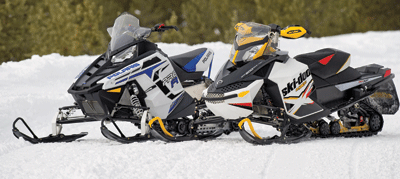Polaris 600RR: Mogul Killer
The 600RR was so new when Polaris unveiled the sled at its 2008 media intro last winter that a sample hadn’t even been built yet.
Normally, we get to ride pre-production sleds at media introductions. Instead, we had to settle for pictures, a spec sheet and claims of “race-proven toughness” from the marketing staff.
But waiting until spring to catch our first ride on the 600RR was worth it.
The new, mogul-killing 600RR brings a new level of snowmobile suspension ability to the trails. Time on a rutted obstacle course of a test trail proved that this sled’s suspensions are king.
Sled, Meet Moguls
Without a doubt, the 600RR has the most-capable big-bump suspensions of all time. It can be driven into or over the deepest, nastiest moguls at higher speeds than any other snowmobile. The front is especially impressive.
It sucked up everything from the very small stutters all the way through the hard 4-footers with ease and seemed to ask for more. The rear end was just as capable here as it happily slammed into the face of the tall moguls without pitching us off course. The only place it felt harsh was in small stutters.
Behind The Bars
Looking ahead from behind the bars, the short body looks weird. The snub-nosed sled is short and it doesn’t seem possible that the nose could hook a mogul no matter how far out of shape the sled might get.
Going down the trail, the sled was loud. Mysteriously, the annoying drivetrain whine that was prevalent on Polaris EDGE models has made its way to the IQ racer. We heard more intake, engine and exhaust noise than regular IQ-based machines. Maybe the lightweight hood and side panels carry less insulation or they don’t seal as tightly.
The 600RR isn’t a sled for fat guys because they’ll wear out — quickly. To command it, drivers need to stand; we only used the seat on straightaways after we learned that’s how the sled performs best. To slice through the woods, we leaned into corners and pointed our knee through the curves while pulling the opposite handlebar through the turns.
The swaybar-free front suspension hooked a line and stuck to it. If you load the front end with body weight, the skis feel well-planted and make riders confident the sled will hold its line. What a blast this sled is to ride once you figure it out.
Short Rides Are Best
Polaris said not to expect comfort and convenience from the 600RR. We agree. Wind protection is nil, at best. This is a good machine to run for a few hours at a time, but leave it in the garage if air temperatures fall to near the 10 degrees Fahrenheit mark.
The tall handlebars put the driver’s fingers in a cold position. Fortunately for us, we rode the machine in 50-degree weather. Optional hand guards will help in cold weather. Regarding convenience, at least the sled has oil injection to make fuel stops easy.
The seat/tank setup works well for stand-up riding. It’s narrow and firm for a dirtbike feel but soft enough to provide comfort if you sit. The two-step seat made us unsure where to sit when going through the trails. Unfortunately, the right spot seemed to be at the transition between the upper and lower cushions. We expected better foot traction from a race sled.
Serviceability
The carbureted 600 HO engine is tucked nice and low in the chassis for a low center of gravity. Side panels stayed put over the rough sections and snapped off and on easily. The airbox appears easy to remove once the secondary clutch is pulled off the jackshaft. The Walker Evans clicker shocks are easy to adjust with a solid detent to indicate each “click.”
Fit and finish was a bit crude, even for a race sled. The rear bumper, handle bar controls and side panels would benefit from a nicer finish. It’s a crap shoot to determine how much fuel is in the tank.
Owners could remove the black vinyl cover to reveal the clear fuel tank, but sunlight is bad for fuel. Polaris should include a hook and loop flap over a sight window. Oh yeah, it said not to expect comfort and convenience from the 600RR. Our bad.






